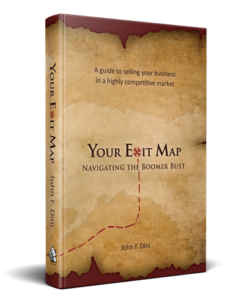In the past few weeks we’ve discussed how quality of earnings audits look at your income and expenses, and their impact on company value. Since Revenue less Expenses equals Profit (P=R-E), you could be forgiven for thinking that we have picked apart your earnings as much as possible.
Unfortunately, that’s not the case. Merely dissecting your customers, lines of business, contracts, one-time expenses and unrecognized liabilities isn’t enough. Quality of earnings also examines how your cash flows.
Accounts Receivable
Just selling at a decent margin isn’t enough. That margin suffers from invisible erosion if your customers don’t pay on time. I’ve heard plenty of owners say ” They are our biggest customer, even if they don’t pay for 90 days.”
Buyers may look at that as “financing” the customers average balance. Even if you aren’t borrowing for working capital, that is money that might be more efficiently used elsewhere.
The math of earnings quality assigns an interest rate to those funds. If the customer takes three months to pay, and maintains an average over-30 balance of $500,000, a 6% cost-of-funds calculation could lop $30,000 from your earnings. If the offered multiple is 5x, that’s $150,000 deducted from your sale price.
Working Capital Needs
Another oft-heard claim by sellers is “This company could grow a lot, if only we had the capital.” Don’t be surprised if an experienced buyer tries to use that to lower their price.
I don’t think this one is necessarily fair. If your valuation is based on past performance, then what the buyer plans for the future is his problem. It has little to do with the numbers underlying your value. None the less, some buyers will put it on the table as a negotiating tactic.
On the other hand, if your selling price includes projections of future performance, or there are obvious issues of deferred maintenance (all your computers still run on Windows 7 for example), then expect an attempt to deduct the additional cash needed right after closing from the purchase price.
Run Rates
Most of us anticipate that a fast growing company will demand a higher multiple than a slow-growing or flat business. That doesn’t mean a buyer won’t try to “double dip” by offering a lower multiple and discounting for performance in the post-LOI due diligence period. Angry sellers will exclaim “But you knew my numbers before you made the offer!” True, but if an outside auditor emphasizes a lack of revenue or profit growth in his report, expect it to be on the table again.
 It will absolutely be an issue if your growth rate falters during due diligence. It’s hard to go through the machinations of a transaction and pay attention to driving the company at the same time. Just be aware that taking your foot off the gas will be noticed, and accounted for.
It will absolutely be an issue if your growth rate falters during due diligence. It’s hard to go through the machinations of a transaction and pay attention to driving the company at the same time. Just be aware that taking your foot off the gas will be noticed, and accounted for.
The bigger issue is when growth on your top line isn’t equaled or exceeded on your bottom line. It may indicate that you are “buying business” with discounting. Failure to increase margins with additional volume may point to a lack of scalability. Either will become a part of the discussion on final price.
Quality of Earnings
In my three columns in this topic, we’ve examined eight major areas where a buyer can claim your earnings are worth less than they seem to be. I’m not an auditor. I’m pretty sure they could point to a few more.
The biggest single point I’d like to drive home is this. Most business owners consider the Letter of Intent to be the end of a negotiating road. When it comes to savvy buyers, it may just be the beginning.
“Read” my new book in 12 minutes!
 Your Exit Map, Navigating the Boomer Bust is now available on Amazon, Barnes & Noble and wherever books are sold. It is ranked the #1 new release in its category on Amazon, and is supplemented by free tools and educational materials at www.YourExitMap.com.
Your Exit Map, Navigating the Boomer Bust is now available on Amazon, Barnes & Noble and wherever books are sold. It is ranked the #1 new release in its category on Amazon, and is supplemented by free tools and educational materials at www.YourExitMap.com.
Now, we have a really cool 12 minute animated video from our friends at readitfor.me that summarizes the book, and helps you understand why it is so different from “how to” exit planning tomes. Take some time to check it out here!
 The first is accrued vacation or PTO. It is customary to keep records of this liability off the balance sheet, but professional buyers don’t see it that way. The benefit was earned while producing for the seller. They buyer has no reason to pay it out for work that wasn’t done for him.
The first is accrued vacation or PTO. It is customary to keep records of this liability off the balance sheet, but professional buyers don’t see it that way. The benefit was earned while producing for the seller. They buyer has no reason to pay it out for work that wasn’t done for him. A single customer who accounts for 10% of your business may not warrant a price discount, but one who controls 20% or more of your revenue almost certainly will trigger renegotiation. You may have a decades-long friendship with that business, but a buyer has little confidence that he or she can maintain the same relationship.
A single customer who accounts for 10% of your business may not warrant a price discount, but one who controls 20% or more of your revenue almost certainly will trigger renegotiation. You may have a decades-long friendship with that business, but a buyer has little confidence that he or she can maintain the same relationship. Dini says that many owners “hand off” their companies without a real succession plan, especially when the business is destined to stay in the family. In those cases, ownership is often passed on while control remains—officially or unofficially—in the hands of the original owner, which can cause significant problems.
Dini says that many owners “hand off” their companies without a real succession plan, especially when the business is destined to stay in the family. In those cases, ownership is often passed on while control remains—officially or unofficially—in the hands of the original owner, which can cause significant problems. Similarly, it you are regularly buttressing your revenues with cuts in margin through big discounts or volume deals, it will be perceived by a prospective buyer as regularly having to “save” the business.
Similarly, it you are regularly buttressing your revenues with cuts in margin through big discounts or volume deals, it will be perceived by a prospective buyer as regularly having to “save” the business.